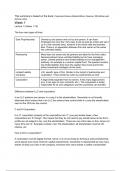Samenvatting
Finance and Investment Summary (First half of course) for Economics Tilburg University. Grade achieved using summary: 9.5/10.
- Instelling
- Tilburg University (UVT)
Even though the course decided to switch up its name recently (previously called Business Economics 2 for ECO: Finance), the content remains the same, all condensed into this 16 page summary, including examples for the first half of the course. The summary is based off ALL video lectures, slides, a...
[Meer zien]







